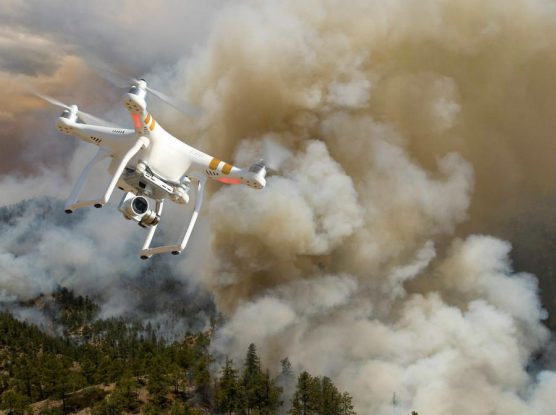California Governor Gavin Newsom unveiled plans Friday to create a $10.5 billion wildfire recovery fund along with other provisions to address the crisis caused by large devastating wildfires over the past two years.
“Climate change has created a new reality in the state of California. It’s not a question of ‘if’ wildfire will strike, but ‘when,’” said Newsom in the introduction of the report. “Our recent, terrifying history bears that out.”
Newsom said it is imperative to simultaneously hold large investor-owned utilities accountable to maintain and upgrade their infrastructure, particularly as it relates to wildfires, while helping ensure the entities are solvent so ratepayers across the Golden State will continue receiving affordable and reliable electricity.
The wildfire recovery fund, which could climb as high as $21 billion, is the centerpiece of Newsom’s Strike Force Progress Report, and will be partially capitalized by ratepayers through a $2.50 surcharge on their monthly bills. The numbers generated by Newsom are based on the projected participation of all three major California utilities – San Diego Gas & Electric, Southern California Edison and Pacific Gas & Electric.
PG&E’s access to the fund is contingent on adequate resolution of liability claims stemming from the 2017-18 fires and an expeditious conclusion to its ongoing bankruptcy proceedings. Its investors met at the company headquarters in San Francisco on Friday to elect a new board.
The creation of the fund will have to win support from the Legislature. State Senator Bill Dodd, D-Napa, said he and his fellow legislators will continue to work with the governor on refining the way forward.
“We look forward to carefully vetting the details of his draft and engaging in a collaborative process to develop a solution,” Dodd said. “My ultimate focus remains on protecting ratepayers from undue costs, ensuring victims are compensated and on improving safety for all Californians.”
Utilities in California would only be able to access the wildfire recovery fund if they comply with strict safety standards that include getting certified annually. The certification process will be tied to executive pay and the utilities would be compelled to spend $3 billion on infrastructure safety projects from which investors can’t profit.
“It’s a plan we can back,” said Patrick McCallum, co-chair of Up from the Ashes, a wildfire victims fund. “I think it protects future wildfire victims.”
Newsom unveiled his plan as PG&E continues to progress through Chapter 11 bankruptcy proceedings, overseen by a federal judge. It also comes in advance of a potential downgrade from credit ratings agencies on Wall Street, which could affect PG&E’s ability to access the capital necessary to upgrade its systems and carry out its promises to reorient its grid to include more renewable energy sources.
Newsom’s proposal stopped short of jettisoning inverse condemnation – a recommendation of his task force and something investors are clamoring for as well.
Inverse condemnation puts utilities at fault for wildfires started by their equipment regardless of whether the utilities were negligent in the maintenance or operation of the equipment.
McCallum said protecting liability standards is a priority, saying the only reason PG&E has begun to take infrastructure safety seriously is because of the recent financial repercussions associated with liability.
“Indications are they are moving as fast as they can trying to mitigate safety concerns,” he said. “But without liability, I don’t know if they change their patterns.”
Karla Peterson, who chaired Newsom’s wildfire task force, said moving to a fault-based system would soothe investor fears, free up capital and give companies like PG&E the incentive to bring equipment up to current safety standards.
Newsom’s plan also calls for the creation of the Wildfire Safety Division, a separate oversight agency within the California Public Utilities Commission capable of closely monitoring utilities and their compliance with newly implemented safety standards.
The Legislative Analyst’s Office issued a report Friday on the proposals under consideration, concluding as much as $40 billion might be necessary for a wildfire fund.
But McCallum said $21 billion along with safety certifications is sufficient to protect future victims of wildfires. And while he is bullish on Newsom’s plan to address the future, he is less so on the plan’s ability to reconcile issues of the past.
“Help for 2017-18 victims remains a concern for us,” he said.
Newsom said he hopes to have the package approved by mid-July before the California fire season starts in earnest.
— By Matthew Renda
Like this:
Like Loading...
Related





 Tweet This
Tweet This Facebook
Facebook Digg This
Digg This Bookmark
Bookmark Stumble
Stumble RSS
RSS


























REAL NAMES ONLY: All posters must use their real individual or business name. This applies equally to Twitter account holders who use a nickname.
2 Comments
What a surprise! The public will have to pick up the bill for the private utilities so that their investors don’t lose. Not to mention the private insurance companies – wait until you see your insurance bill, if you live anywhere near open space you are in for a shock. Mine increased by 35 percent.
And in Los Angeles and Santa Clarita we have homeless camps starting wildfires as happened a few weeks ago again with three fires in one day. It would certainly be less expensive to forbid those folks to camp illegally in fire prone areas and get them into shelters than pay for the damage they will cause when they start fires. The City needs to assist the homeless to get out of the river and not allow illegal camping there.
Dimwhit Newsome will do the same as Moonbeam did with the CalFire Tax.. Those dollars were to go to CalFire and he collected them and then transferred them to the General Fund to pay for all the illegals services… Why do we, as property owners, have to take the brunt of this…